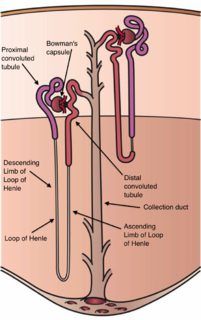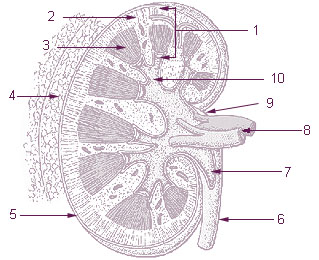
The kidneys are two bean-shaped organs found in vertebrates. They are located on the left and right in the retroperitoneal space, and in adult humans are about 11 centimetres (4.3 in) in length. They receive blood from the paired renal arteries; blood exits into the paired renal veins. Each kidney is attached to a ureter, a tube that carries excreted urine to the bladder.

The nephron is the microscopic structural and functional unit of the kidney. It is composed of a renal corpuscle and a renal tubule. The renal corpuscle consists of a tuft of capillaries called a glomerulus and an encompassing Bowman's capsule. The renal tubule extends from the capsule. The capsule and tubule are connected and are composed of epithelial cells with a lumen. A healthy adult has 0.8 to 1.5 million nephrons in each kidney. Blood is filtered as it passes through three layers: the endothelial cells of the capillary wall, its basement membrane, and between the foot processes of the podocytes of the lining of the capsule. The tubule has adjacent peritubular capillaries that run between the descending and ascending portions of the tubule. As the fluid from the capsule flows down into the tubule, it is processed by the epithelial cells lining the tubule: water is reabsorbed and substances are exchanged ; first with the interstitial fluid outside the tubules, and then into the plasma in the adjacent peritubular capillaries through the endothelial cells lining that capillary. This process regulates the volume of body fluid as well as levels of many body substances. At the end of the tubule, the remaining fluid—urine—exits: it is composed of water, metabolic waste, and toxins.

Hydrochlorothiazide is a diuretic medication often used to treat high blood pressure and swelling due to fluid build up. Other uses include diabetes insipidus, renal tubular acidosis, and to decrease the risk of kidney stones in those with a high calcium level in the urine. For high blood pressure it is sometimes considered as a first-line treatment, although chlorthalidone is more effective with a similar rate of adverse effects. HCTZ is taken by mouth and may be combined with other blood pressure medications as a single pill to increase effectiveness.

The renal medulla is the innermost part of the kidney. The renal medulla is split up into a number of sections, known as the renal pyramids. Blood enters into the kidney via the renal artery, which then splits up to form the interlobar arteries. The interlobar arteries each in turn branch into arcuate arteries, which in turn branch to form interlobular arteries, and these finally reach the glomeruli. At the glomerulus the blood reaches a highly disfavourable pressure gradient and a large exchange surface area, which forces the serum portion of the blood out of the vessel and into the renal tubules. Flow continues through the renal tubules, including the proximal tubule, the Loop of Henle, through the distal tubule and finally leaves the kidney by means of the collecting duct, leading to the renal pelvis, the dilated portion of the ureter.

The glomerulus, plural glomeruli, is a network of capillaries known as a tuft, located at the beginning of a nephron in the kidney. The tuft is structurally supported by intraglomerular mesangial cells. The blood is filtered across the capillary walls of this tuft through the glomerular filtration barrier, which yields its filtrate of water and soluble substances to a cup-like sac known as Bowman's capsule. The filtrate then enters the renal tubule, of the nephron.

Chronic kidney disease (CKD) is a type of kidney disease in which there is gradual loss of kidney function over a period of months or years. Early on there are typically no symptoms. Later, leg swelling, feeling tired, vomiting, loss of appetite, or confusion may develop. Complications may include heart disease, high blood pressure, bone disease, or anemia.
Essential hypertension is the form of hypertension that by definition has no identifiable cause. It is the most common type of hypertension, affecting 95% of hypertensive patients, it tends to be familial and is likely to be the consequence of an interaction between environmental and genetic factors. Prevalence of essential hypertension increases with age, and individuals with relatively high blood pressure at younger ages are at increased risk for the subsequent development of hypertension. Hypertension can increase the risk of cerebral, cardiac, and renal events.

Chlortalidone, also known as chlorthalidone, is a diuretic medication used to treat high blood pressure, swelling including that due to heart failure, liver failure, and nephrotic syndrome, diabetes insipidus, and renal tubular acidosis. In high blood pressure it is a preferred initial treatment, in resistant high blood pressure chlortalidone is preferred over hydrochlorothiazide. It is also used to prevent calcium-based kidney stones. It is taken by mouth. Onset being within three hours and lasts for up to 3 days.
Hydronephrosis describes urine-filled dilation of the renal pelvis and/or calyces as a result of obstruction.

Renovascular hypertension is a condition in which high blood pressure is caused by the kidneys' hormonal response to narrowing of the arteries supplying the kidneys. When functioning properly this hormonal axis regulates blood pressure. Due to low local blood flow, the kidneys mistakenly increase blood pressure of the entire circulatory system. It is a form of secondary hypertension - a form of hypertension whose cause is identifiable.

Fenoldopam mesylate (Corlopam) is a drug and synthetic benzazepine derivative which acts as a selective D1 receptor partial agonist. Fenoldopam is used as an antihypertensive agent. It was approved by the Food and Drug Administration (FDA) in September 1997.
Renal ischemia also known asnephric ischaemia, is the deficiency of blood in one or both kidneys or nephrons, usually due to functional constriction or actual obstruction of a blood vessel.

11-Deoxycorticosterone (DOC), or simply deoxycorticosterone, also known as 21-hydroxyprogesterone, as well as desoxycortone (INN), deoxycortone, and cortexone, is a steroid hormone produced by the adrenal gland that possesses mineralocorticoid activity and acts as a precursor to aldosterone. It is an active (Na+-retaining) mineralocorticoid. As its names indicate, 11-deoxycorticosterone can be understood as the 21-hydroxy-variant of progesterone or as the 11-deoxy-variant of corticosterone.
Hypertensive encephalopathy (HE) is general brain dysfunction due to significantly high blood pressure. Symptoms may include headache, vomiting, trouble with balance, and confusion. Onset is generally sudden. Complications can include seizures, posterior reversible encephalopathy syndrome, and bleeding in the back of the eye.

Calcium gluconate is a mineral supplement and medication. As a medication it is used by injection into a vein to treat low blood calcium, high blood potassium, and magnesium toxicity. Supplementation is generally only required when there is not enough calcium in the diet. Supplementation may be done to treat or prevent osteoporosis or rickets. It can also be taken by mouth but is not recommended for injection into a muscle.

Cilnidipine is a calcium channel blocker. Cilnidipine is approved for use in Japan, China, India, Korea, and some European countries to treat hypertension.

Efonidipine (INN) is a dihydropyridine calcium channel blocker marketed by Shionogi & Co. of Japan. It was launched in 1995, under the brand name Landel (ランデル). The drug blocks both T-type and L-type calcium channels. Drug Controller General of India (DCGI) granted approval to Zuventus Healthcare Limited for marketing efonidipine under brand name Efnocar in India.
Renal sympathetic denervation (RSDN), is a minimally invasive, endovascular catheter based procedure using radiofrequency ablation or ultrasound ablation aimed at treating resistant hypertension. Nerves in the wall of the renal artery are ablated by applying radiofrequency pulses or ultrasound to the renal arteries. This causes reduction of sympathetic afferent and efferent activity to the kidney and blood pressure can be decreased. Early data from international clinical trials without sham controls was promising - demonstrating large blood pressure reductions in patients with treatment-resistant hypertension. However, in 2014 a prospective, single-blind, randomized, sham-controlled clinical trial failed to confirm a beneficial effect on blood pressure. A 2014 consensus statement from The Joint UK Societies did not recommend the use of renal denervation for treatment of resistant hypertension on current evidence.
Thomas G. Pickering was a British physician and academic. He was a professor of medicine at College of Physicians and Surgeons, Columbia University Medical Center in New York City. He was an internationally renowned expert in clinical hypertension and a leader in the fields of hypertension and cardiovascular behavioral medicine. He coined the term "white-coat hypertension" to describe those whose blood pressure was elevated in the doctor's office, but normal in everyday life. He later published the first editorial describing "masked hypertension". He also discovered and gave his name to the Pickering Syndrome, where bilateral renal artery stenosis causes flash pulmonary edema.
















